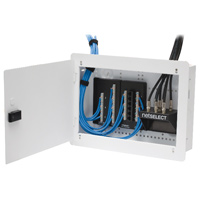
Structured wiring is not necessarily Ethernet.
Broadband cabling is fast becoming a standard feature in new homes built in the U.S., with 92% being pre-wired to one degree or another. Many include sophisticated video and/or data distribution networks. That’s the conclusion of a report just released by the Consumer Electronics Association (CEA).
The CEA’s eleventh annual State of the Builder study found that “structured wiring” is installed in 70% of new homes. That doesn’t necessarily mean all of those homes are completely wired for Internet. Structured wiring is a term that refers to a relatively sophisticated network architecture in a home, typically focused on a central distribution hub that’s fed by outside services, such has cable, DSL, satellite or telephone. But it doesn’t have to include all those sources. A structured wiring system might be set up just to distribute cable TV, for example.
Another of the report’s findings is that home networking is increasingly being viewed as a basic necessity, rather than a luxury. The percentage of new homes built with structured wiring crashed along with the housing market in 2008. In the last couple of years, though, despite sluggish growth in new home construction, the proportion of homes built with structured wiring is back to 2008 levels. The overall percentage of new homes with some level of built in broadband cabling has continued to rise, from 36% in 2002 to 92% in this latest report.
Although figures weren’t given, the CEA release said that remodelers are also doing more broadband cabling business than before. It’s another indication of greater willingness among U.S. consumers to spend money on broadband facilities, on top of service.
